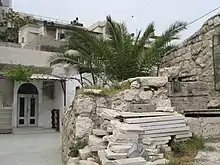Ein Rogel
Ein Rogel (Hebrew: עין רגל, Ein Rogel), was a spring on the outskirts of Jerusalem mentioned in the Hebrew Bible as the hiding-place of David's spies, Jonathan and Ahimaaz, during Absalom's uprising against the rule of King David (2 Samuel 17:17). It may also have been a sacred place in pre-Israelite times.[1]
Spelling variants
In English it also appears as Enrogel (2 Samuel 17:17, King James Version), En-rogel (2 Samuel 17:17, American Standard Version and English Standard Version), or En Rogel (2 Samuel 17:17, NIV and NKJV).
Hebrew Bible accounts
En Rogel was one of the boundary marks between Judah and Benjamin (Joshua 15:7, 18:16).
During Absalom's uprising against David, Jonathan and Ahimaaz stayed at Ein Rogel, "for they dared not be seen coming into the city (Jerusalem); so a female servant would come and tell them, and they would go and tell King David". However, "a lad saw them, and told Absalom", and so they had to flee to Bahurim (2 Samuel 17:17–18).
Ein Rogel lay close to a stone, Zoheleth, where Adonijah, Solomon's half-brother of, held a sacrificial feast when he attempted to assert his claims to the throne (1 Kings 1:9).[1][2] The obviously sacred character of the spring suggests that it is the same as the Dragon Well or Serpent Well of Nehemiah 2:13.[1]
Meaning
As of 1901, the meaning of the name was uncertain.[1] The interpretation 'Fuller's Well' does not bear the mark of antiquity. It is probable that, like Zoheleth, the original name had some sacred or mythic significance.[1]
Location

Recent scholars identify Ein Rogel with Bir Ayyub[2] (also spelled Ayub, Ayoub). It is located just south of the junction of the three valleys - Hinnom, Central and Kidron.[3] Today there is a modern pumping station there, drawing water from a 38 m deep well, whose stone lining may be partially of Roman date.[2] Bir Ayoub (Arabic: بئر أيوب) translates to "Fountain of Job" or "Job's Well", also known as Joab's Well. Today the Bir Ayoub Mosque of Silwan stands above the Bir Ayoub well.
As of 1901, the identification was uncertain, two locations being suggested:
- (1) Virgin's fountain ('Ain Sitti Maryam), later 'Ain Umm ed-Deraj, 'the only real spring close to Jerusalem', exactly opposite to which lies ez-Zehweleh, perhaps Zoheleth;[1] and
- (2) Bir Ayub, also known as the Well of Nehemiah, at the junction of two valleys, Wadi er-Rababi and Kidron. However, Bir-Ayub is a well, not a spring, and lies too far from ez-Zehweleh, although it lies near a large stone in Siloam village called Zehwillat. As Bir Ayub is in full view of the city, it does not suit the context of 2 Sam. 17:17, and its antiquity is uncertain.[1]
The chief points in favour of (1) are its antiquity and the evidence of Josephus, who places the well in the royal gardens.[4] Other arguments are based upon the fact that in later times the well was used by fullers.[1]
Ein Rogel is mentioned in "Topography of Jerusalem", a document found in the Cairo Geniza, which describes how the water breaks through to the riverbed after a winter of plentiful rainfall.[5]
Bir Ayub: gallery
 Bir Ayub on 1840 illustration from The Holy Land, Syria, Idumea, Arabia, Egypt, and Nubia
Bir Ayub on 1840 illustration from The Holy Land, Syria, Idumea, Arabia, Egypt, and Nubia_(28700151844).jpg.webp) Nehemiah's Well on double, or stereoscopic photo card, Bonfils, ca. 1870.
Nehemiah's Well on double, or stereoscopic photo card, Bonfils, ca. 1870._%D7%91%D7%90%D7%A8_%D7%99%D7%95%D7%90%D7%91_%D7%9C%D7%9E%D7%A8%D7%92%D7%9C%D7%95%D7%AA_%D7%94%D7%A9%D7%99%D7%9C%D7%95%D7%97_%D7%91%D7%99%D7%A8%D7%95%D7%A9%D7%9C%D7%99%D7%9D.D826-058.jpg.webp) Bir Ayub in 1910
Bir Ayub in 1910 Ein Rogel in the mid 19th century
Ein Rogel in the mid 19th century
External links
References
- Cheyne, Thomas Kelly; Black, J. Sutherland, eds. (1901). En-rogel. Encyclopaedia Biblica. 2. Toronto: George N. Morang & Company. p. 1297. Retrieved 24 August 2020.
- Murphy-O'Connor, Jerome (2008). The Holy Land: An Oxford Archaeological Guide from Earliest Times to 1700. Oxford Archaeological Guides. Oxford University Press. ISBN 978-0-19-923666-4. Retrieved 24 August 2020.
- Curtis, Adrian, ed. (2007). Jerusalem in the 1st Millennium BCE. Oxford Bible Atlas (4th ed.). Oxford University Press. pp. 141, 143 (map). ISBN 978-0-19-100158-1. Retrieved 24 August 2020.
- Anti. vii. 14 4
- Gil, Moshe (1996). Prawer, Joshua; Ben-Shammai, Haggai (eds.). The Political History of Jerusalem during the Early Muslim Period: The Jewish Community. The History of Jerusalem: The Early Muslim Period (638-1099). Yad Yzhak Ben-Zvi & NYU Press. p. 173. ISBN 9780814766392. Retrieved 14 August 2020.
 This article incorporates text from a publication now in the public domain: Cheyne, Thomas Kelly; Black, J. Sutherland, eds. (1901). . Encyclopaedia Biblica. 2. location: George N. Morang & Company.
This article incorporates text from a publication now in the public domain: Cheyne, Thomas Kelly; Black, J. Sutherland, eds. (1901). . Encyclopaedia Biblica. 2. location: George N. Morang & Company.